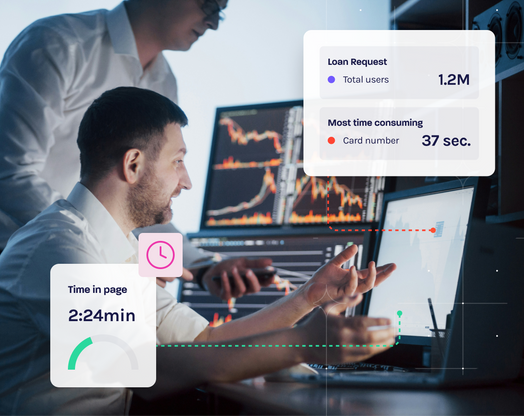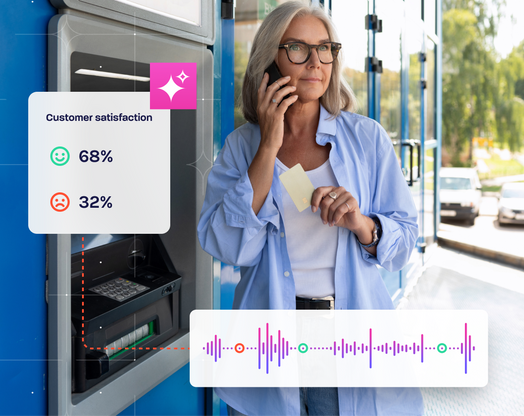
AI in Banking: How AI is Transforming Financial Services
Artificial intelligence isn’t just a buzzword, it’s a growth engine that’s rapidly redefining the banking landscape. Consider that the global AI in finance market is projected to grow from $38.36 billion in 2024 to $190.33 billion by 2030, reflecting a robust compound annual growth rate of 30.6%. This explosive growth isn't just theoretical; it’s driving real-world results. According to NVIDIA’s State of AI in Financial Services report, 70% of financial institutions attribute at least a 5% increase in revenue to their AI initiatives, while over 60% report cost savings of 5% or more. These findings highlight how AI is delivering tangible performance improvements across the sector.
Much of this momentum stems from a banking sector racing to digitize. Competitive pressure from fintechs, shifting customer expectations and stricter compliance demands have all accelerated AI-driven digital transformation. When the right models, algorithms and systems are in place, banks gain the power to parse vast amounts of customer data, spot fraud patterns in milliseconds and personalize every interaction—in real time.
AI is driving some of the most dramatic changes in banking, from fraud detection and risk mitigation to 24/7 customer service, hyper-personalized experiences and streamlined operations. Emerging generative AI tools are further elevating automation and insight.
Central to these advancements is AI-powered digital analytics, which captures every click, tap and swipe across web and mobile channels to deliver a 360-degree view of customer behavior. This intelligence is enabling banks to offer more efficient, secure and personalized experiences. This meets the rising expectations of both customers and regulators.
Discover how AI models and tools, from fraud-fighting algorithms to generative AI assistants, are reshaping financial services and find out how Glassbox’s GIA solution can help you assess where AI can drive the greatest value for your company.
What Is AI in Banking?
At its core, AI in banking refers to the use of advanced computational techniques, including machine learning (ML), natural language processing (NLP) and predictive analytics, to interpret data, learn from patterns and make informed decisions.
ML models analyze historical and real-time transactions to flag anomalies, NLP enables chatbots to understand and respond to customer queries in natural language, and predictive analytics forecasts everything from credit risk to customer churn.
Unlike traditional automation that simply follows predefined rules, AI systems adapt. A legacy script might route every wire transfer over a set amount for manual review, while an AI model considers dozens of variables—device ID, transaction history and geolocation—to decide in milliseconds whether that same transfer is legitimate or suspicious. This shift from rule-based processing to intelligent decision-making delivers higher accuracy, faster response times and reduced operational overhead.
Generative AI, the newest chapter in this evolution, brings creativity to the mix. Powered by large language models (LLMs), gen AI can draft personalized financial advice, summarize regulatory changes or even generate code to streamline compliance workflows. Early movers like Deutsche Bank are already piloting gen AI to surface insights for analysts and improve operational efficiency.
How AI Is Used in Banking Today
Across the banking sector, AI has moved from pilot projects to mission-critical systems that touch nearly every customer and employee interaction. AI algorithms safeguard transactions, enhance service and drive revenue.
Fraud Detection and Risk Mitigation
Fraudsters continually refine their tactics, but AI systems evolve even faster. By combining real-time data ingestion with machine-learning algorithms, banks can monitor every transaction across cards, accounts and channels, then score each one for risk in milliseconds.
AI’s strength lies in pattern recognition at scale. Models evaluate hundreds of variables, from device fingerprints to spending velocity, to flag anomalies that human analysts may miss.
When integrated with robotic process automation, AI models create an end-to-end risk management framework that adapts to new fraud patterns without continual rule rewrites. The result is faster interdiction, lower operational costs and a stronger security posture that builds customer trust.
AI-Powered Customer Service and Chatbots
Customers expect answers in seconds, not minutes. AI-powered chatbots deliver that immediacy by combining natural language processing with deep banking knowledge. Additionally, AI chatbots are always available. This translates into round-the-clock and multilingual assistance. Whether a customer is checking a balance at 2 a.m. in New York or applying for a card from Singapore, conversational AI agents handle routine inquiries, authenticate users with biometrics and even walk them through transactions in their preferred language. This results in improved customer satisfaction, which is further enhanced by LLMs that interpret nuance, detect sentiment and personalize responses. For example, if a customer types “I’m worried about overdraft fees,” an advanced natural language processing engine can recognize the concern, pull recent account activity and proactively suggest low-balance alerts or tailored credit products. This blend of empathy and data-driven insight boosts satisfaction while surfacing new revenue opportunities.
Loan Approvals and Credit Decisions
Traditional credit scoring leans heavily on a narrow set of variables, primarily payment history and outstanding debt. AI broadens the lens, processing alternative data points such as utility and telco payments, rental history, mobile-wallet activity and even patterns in customer engagement. By training sophisticated AI models on this richer data mix, banks can predict default risk more accurately and make fairer lending decisions. This can translate into real financial inclusion, giving credit-worthy consumers—gig-economy workers, recent immigrants or young professionals—the opportunity to build financial stability.
However, AI doesn’t just expand the applicant pool, it accelerates the underwriting cycle. Models ingest real-time financial data, auto-populate forms, highlight anomalies and present an instant risk assessment to loan officers. The result of these faster decisions is improved customer experience and reduced pipeline drop-off.
Automation of Back-Office Operations
Robotic Process Automation has long handled high-volume, rule-based tasks such as data entry and reconciliation. Layering AI on top of those bots turns simple macros into intelligent agents that can read documents, classify exceptions and learn from historical outcomes. These time savings flow directly to the bottom line and free employees to focus on value-added analysis rather than repetitive keystrokes.
Intelligent Process Automation (IPA) pushes the concept even further by blending machine learning, natural language processing and process-mining analytics into a continuous improvement loop.
An IPA framework enhances compliance and operational efficiency by automating complex, data-driven tasks. It can parse unstructured data, such as scanned statements, email threads and voice transcripts, and auto-populate core banking systems. IPA also cross-references transactions with sanctions lists in real time to meet Know Your Customer (KYC), anti-money laundering and customer due diligence requirements, while generating comprehensive audit trails to support regulatory oversight of model governance and data lineage. Additionally, it uses AI algorithms to detect process bottlenecks, recommending or even implementing optimizations autonomously. To maintain regulatory compliance, IPA frameworks can monitor model drift and trigger retraining when accuracy declines, aligning with evolving standards like the EU AI Act and proposed U.S. AI risk-management guidelines.
By embedding AI into each stage of the workflow—data capture, validation, decision-making and audit—banks gain a self-healing operational fabric that scales effortlessly and meets stringent privacy laws like the General Data Protection Regulation (GDPR) and California Consumer Privacy Act (CCPA).
Personalized Banking and Customer Relationship Management
AI has unlocked a new tier of personalization that was impossible with static segmentation. By analyzing real-time behavioral data, including every click, swipe and dwell time, AI models build dynamic profiles that predict needs before customers articulate them.
Here’s how hyper-personalization works in practice:
Behavioral analytics platforms, such as Glassbox’s tagless data capture, stream continuous in-session data into machine-learning pipelines.
Predictive models score intent, such as saving for a home, planning travel or reducing debt. They surface the right product or content at the optimal moment.
AI-driven decision engines automatically tailor credit limits, savings goals or investment allocations, which creates a sense of one-to-one service at scale.
Real-time feedback loops measure conversion, iterate offers and refine models, which steadily increase relevance and ROI.
While customers welcome tailored experiences, with 71% expecting companies to deliver personalized interaction and 76% getting frustrated when it doesn’t, regulators and consumers alike demand ironclad data stewardship. Challenges include algorithmic bias, consent management under GDPR and CCPA and the risk of over-personalization that crosses the line. Banks can mitigate these risks by:
Employing privacy-enhancing technologies such as differential privacy and federated learning to keep sensitive data on a device
Auditing models for disparate impact across demographics, then adjusting feature weights to promote fairness
Maintaining transparent consent dashboards that let users view, modify or revoke data permissions
Encrypting in-transit and at-rest data and enforcing strict role-based access controls across AI systems
Financial institutions that strike the right balance enjoy tangible rewards, including higher Net Promoter Scores, deeper wallet share and lower churn.
Generative AI in Banking
Generative AI (gen AI) is the future of banking. Why? Because estimates suggest that gen AI could add $200-$340 billion in annual value to banking, equal to as much as 15% of operating profit.
Building on traditional ML, gen AI creates new content, such as text, code, images and synthetic data, using LLMs like GPT-4. Trained on extensive financial and public datasets, these models can quickly answer complex questions, draft personalized recommendations and summarize lengthy reports.
Glassbox’s GIA brings generative AI directly into digital experience analytics, allowing teams to bypass dashboards and get instant, data-driven answers to natural-language queries. By automating deep analytics, GIA empowers product, CX and compliance teams to focus on strategic initiatives that drive KPIs instead of sifting through raw data.
As generative AI continues to enhance customer engagement and decision-making, it’s a timely moment for financial institutions to evaluate the broader impact of AI and identify where they stand to gain the most.
Benefits of AI for Financial Services
Financial institutions increasingly view AI as mission-critical rather than experimental. In Deloitte’s most recent survey, 86% of financial-services AI adopters said the technology will be very or critically important to their success within the next two years, a sentiment echoed by global banks that have already tied AI projects to measurable gains.
Before diving into specific numbers, consider the broad business outcomes executives report after harnessing AI tools, models and systems:
Cost reduction through automated underwriting, KYC checks and document processing
Better customer experience via hyper-personalized offers, fast resolutions and intuitive self-service
Real-time decision-making in areas such as credit risk assessment, liquidity management and portfolio rebalancing
Enhanced regulatory compliance thanks to continuous monitoring, automated audit trails and model governance dashboards
There are increasing examples of banks successfully using AI in their operations. One leading digital-only lender, for example, wanted to minimize abandonment during mobile loan applications while tightening fraud controls. By implementing Glassbox’s tagless data capture and AI-driven journey analytics, the team pinpointed a hidden UX friction point that caused 18% of qualified applicants to drop off at the document-upload step. After optimizing the flow and deploying real-time behavioral alerts, the fintech recorded:
A 12% uplift in completed applications within six weeks
A 9% reduction in false-positive fraud flags through AI-based risk scoring
A 4-point jump in customer satisfaction scores, reinforcing brand loyalty
While the upside is clear, AI adoption also introduces new challenges, from algorithmic bias to evolving regulations.
Challenges and Risks of AI in Banking
Every breakthrough carries inherent risk. For AI in banking, the most pressing issues revolve around fairness, privacy and regulation—areas that demand as much diligence as model accuracy.
The fact is, AI models inherit biases from the data they learn from. Privacy concerns also loom large, as large-scale data ingestion collides with GDPR and CCPA mandates. Meanwhile, regulators worldwide are drafting new rules, leading to uncertainty around future requirements that can stall deployment.
Why Transparency and Responsible AI Matter
Addressing AI-related risks requires embedding explainability and governance into every layer of the AI stack. This includes using interpretable models or post-hoc explainers to clarify which variables influenced a decision, helping auditors identify potential bias. Continuous performance monitoring is essential to detect model drift before it affects accuracy or regulatory compliance. In parallel, robust data management frameworks must document data lineage, consent and retention policies to meet regulatory standards and maintain customer trust. Finally, partnering with trusted experts ensures that AI implementations are both ethically sound and technically robust.
Few banks have the in-house resources to manage responsible AI alone. Vendors like Glassbox embed privacy by design, using tagless capture that avoids PII, differential privacy techniques and rigorous security certifications. This allows banks to innovate without compromising compliance.
With solid guardrails in place, institutions can focus on the horizon and evaluate where AI will create the next wave of competitive advantage.
Future Trends: What’s Next for AI in Banking?
As financial institutions grow more digitally mature, AI is moving beyond basic automation and personalization. The focus is shifting toward proactive, intelligent systems that can operate with minimal human input.
Predictive analytics is a key part of this shift, helping banks anticipate customer needs by analyzing patterns in behavior and past data. This allows for earlier, more personalized interventions, such as offering financial tools to users showing signs of money stress before issues escalate.
Autonomous finance is also gaining traction. These systems can handle everyday financial tasks such as budgeting, bill payments and investment allocation on behalf of users. The goal is to reduce friction and improve financial outcomes, especially for customers who may not have access to traditional financial planning.
The convergence of AI with technologies like blockchain and the Internet of Things is building a more secure, intelligent financial infrastructure. From real-time fraud detection at ATMs to automated compliance checks, these integrations are laying the groundwork for smarter, more connected services.
However, not all institutions are ready for this level of transformation. In response, AI maturity assessment tools are becoming essential for banks to assess their current capabilities, identify gaps and build a roadmap for responsible and scalable AI adoption.
How an AI-Powered Insights Assistant Can Help
Even with the right AI infrastructure in place, many financial institutions struggle to turn raw data into actionable insight. That’s where a purpose-built AI insights assistant can make a meaningful difference, especially when it's designed specifically for digital-first banking.
Glassbox’s GIA leverages generative AI and natural language processing to surface intelligent recommendations from massive volumes of digital interaction data. Instead of sifting through dashboards or relying on analysts, banking teams can simply ask GIA a question, like “Why are mobile users abandoning the loan application flow?” and receive a clear, contextualized answer in seconds.
What sets GIA apart is its ability to connect customer behavior to business outcomes. Whether it’s uncovering a confusing form field, pinpointing a spike in rage clicks or identifying friction in a mobile deposit flow, GIA helps teams diagnose problems faster and prioritize changes that drive measurable impact.
With GIA, banks can:
Instantly surface friction points and anomalies across digital journeys
Understand the why behind user drop-offs or complaints
Receive AI-suggested next steps to improve conversion, engagement or retention
Empower every team, from product to compliance, with intuitive access to insights
This shifts digital analytics from a reactive, fragmented process to a proactive, integrated one.
Start Your AI Journey Today With Glassbox
The future of banking is AI-powered, but the path forward doesn’t have to be overwhelming. Whether you’re just beginning your transformation or scaling advanced initiatives, Glassbox provides the tools, guidance and intelligence to help every step of the way.
Our platform combines AI-driven analytics, real-time session replay and voice-of-customer data in one unified solution. With Glassbox, your teams don’t need to learn a new tool, they just need to ask the right question. Our GIA puts the power of AI into everyday workflows, helping product, marketing and CX leaders identify opportunities, solve issues and deliver experiences that build loyalty.
Ready to see what AI can do for your bank? Take a platform tour and discover how Glassbox can accelerate your AI strategy today and into the future.







